The definitive Kurt Cobain guitar gear guide: a deep dive into the Nirvana frontman's pawn shop prizes, turbo-charged stompboxes and blown woofers
Decades on from the grunge legend's passing, his tone remains one of the most iconic in guitar's storied history
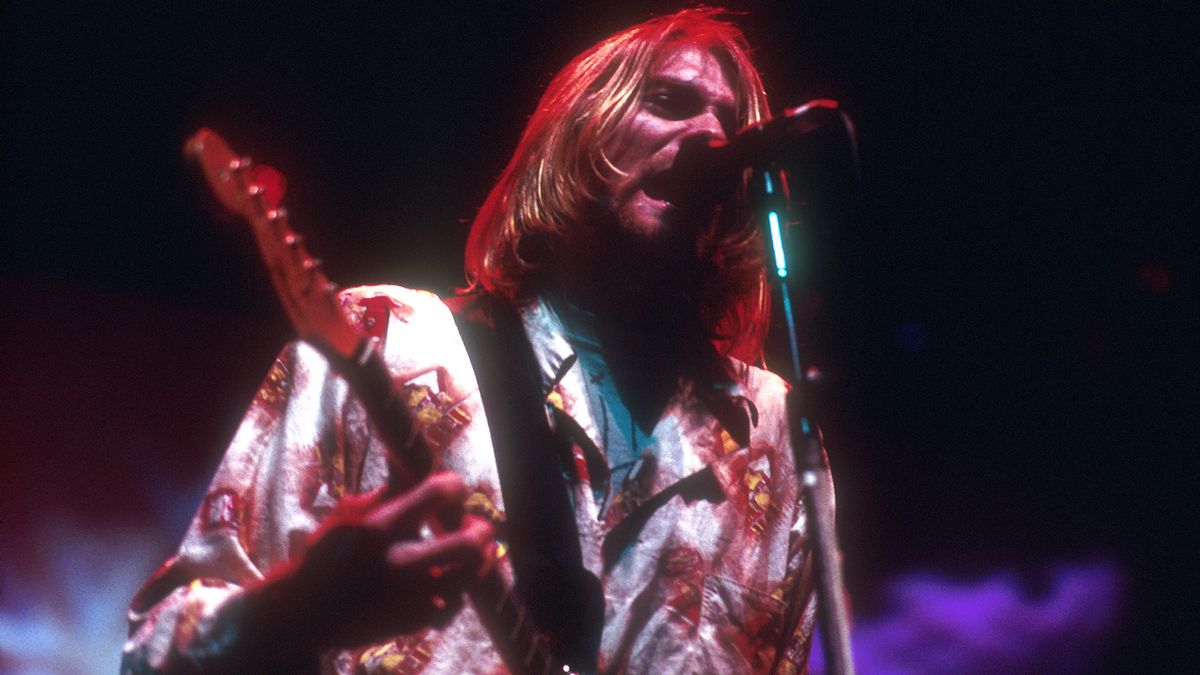
This classic article from the August 1997 issue of Guitar World serves as the definitive guide to Kurt Cobain's grungy assortment of pawn shop guitars, high-octane pedals and essential amps.
Kurt Cobain must have been amused when magazines like Guitar World and Guitar Player requested interviews and when Fender approached him to design a guitar. But here's where another irony exists – although Cobain often said he didn't care very much about equipment, he certainly possessed more than a passing interest in the tools of his trade.
Cobain may not have collected vintage Gibsons, Martins, D'Angelicos and what-not, but he owned an eccentric cache of budget models, low-end imports and pawn shop prizes – most pursued with the same passion as a Gibson collector seeking a mint '59 Les Paul.
Even when he could afford the best, Cobain's taste in instruments never changed. “Junk is always best,” Cobain stated matter-of-factly to Jeff Gilbert in a February 1992 Guitar World interview. “I use whatever I can find at junk shops.”
Over the years, rumors about Cobain using special processors and studio trickery to obtain his sound have proliferated, so we figured the time had come to get to the real bottom of the truth about Cobain's equipment to be revealed.
To do so, we contacted the most reliable sources available – the dealers who sold him his equipment, the engineers and producers who worked with him in the studio and the technicians who looked after his gear on the road.
A couple of well-researched websites, Chris Lawrence's site and Brian Haberman's site [Editor's Note: These websites no longer exist. Remember, this story is from 1997!], also supplied many useful details.
Get The Pick Newsletter
All the latest guitar news, interviews, lessons, reviews, deals and more, direct to your inbox!
Michael Azerrad's Come As You Are: The Story of Nirvana provided excellent background information and photographs, and we also pored over the few interviews on the subject granted by Cobain himself.
Cobain almost certainly would have laughed at the idea of a magazine scrutinizing the minute details of his gear. “I've never considered musical equipment very sacred,” he once said. But for the thousands of guitarists who consider Cobain's music sacred, it's important to understand what he played and why he played it.
Scentless Apprentice: Cobain's virgin musical years
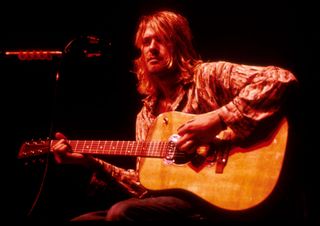
Kurt Donald Cobain was born in Aberdeen, Washington, on February 20, 1967. His first guitar, a used electric, was a 14th birthday present from his uncle Chuck. “As soon as I got my guitar, I just became so obsessed with it,” Cobain told Michael Azerrad. “I don't think it was even a Harmony. I think it was a Sears.”
Cobain took guitar lessons for less than a month – just long enough to learn how to play AC/DC's Back in Black. Those three chords served him well when he began writing his own songs shortly thereafter.
Cobain soon set his sights on forming a band. One day, a couple of friends invited him to jam in an abandoned meat locker they used as a practice space. Afterwards, he foolishly left his guitar in the locker and was subsequently unable to return and get it back.
When he finally made it back to the rehearsal space a few months later, he found his guitar in pieces. He salvaged the neck, hardware and electronics and made a new body for the guitar in wood shop, but Cobain lacked the skills to make the restored instrument intonate properly.
When Cobain was 17, his mother married Pat O'Connor, whose ensuing infidelity led to a situation that greatly facilitated Cobain's acquisition of musical gear. After Cobain's mother learned that Pat was cheating on her, she dumped his gun collection in the river.
Cobain observed his mother's antics and later encouraged some of the neighborhood kids to fish his stepdad's weapons out. Cobain sold the guns and bought a used Peavey Vintage amplifier with two 12-inch speakers with the proceeds.
In early 1985, Cobain moved in with his natural father who discouraged his son's musical pursuits and convinced him to pawn his guitar. After about a week, Cobain got his guitar out of hock and moved out.
I've never considered musical equipment very sacred
Kurt Cobain
He almost lost the guitar again when he loaned it to a drug dealer, but managed to repossess it a few months later. With this unknown guitar and the Peavey amp in hand, Cobain formed his first band, Fecal Matter, in late 1985.
The Peavey amp disappeared sometime between early 1986 and late 1987. Krist Novoselic remembers that Cobain gave the amp to him for about a week, in what apparently was a friendly attempt to get him to join Fecal Matter. Novoselic declined on both offers.
The amp disappeared sometime after that. By late 1987 Novoselic finally agreed to form a band with Cobain and drummer Aaron Burckhard, which they called Skid Row.
Photos from this era show Cobain playing a right-hand model sunburst Univox Hi-Flyer flipped over and strung for left-handed playing.
According to Azerrad, Cobain's amp during this period was a tiny Fender Champ. Also around this time, Cobain acquired a Univox Superfuzz, but it was stolen from his rehearsal space.
The band's name changed frequently, from Fecal Matter to such similarly choice monikers as Ted Ed Fred, Pen Cap Chew, Throat Oyster, Windowpane and Bliss. Eventually they settled on Nirvana.
When Burckhard proved too unreliable, Cobain and Novoselic kicked him out of the band and enlisted drummer Dale Crover, who they temporarily stole from the Melvins.
Three weeks later, on January 23, 1988, Nirvana recorded its first studio demo at Reciprocal Studio with Jack Endino – whose early production/engineering/mixing credits include Soundgarden, Green River, Tad and Mudhoney behind the board.
Blond ambition: The Bleach years
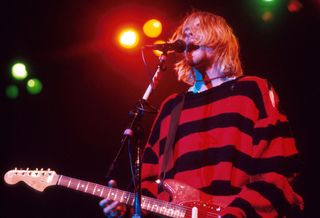
A few months after working with Nirvana for the first time, Endino played the band's demo tape for Jonathan Poneman of Sub Pop Records, who signed the band to the label. Three of the songs that Nirvana recorded during that session ended up on Bleach, the band's first album.
The band liked working with Endino, and they returned to Reciprocal Studios several times during the year to record more songs, although Chad Channing replaced Crover on drums.
Nirvana signed a contract with Sub Pop, and in late December 1988, they entered Reciprocal Studios to record Bleach. The album was recorded in three days for $606.16, although five tracks from earlier sessions were included on the final album.
Most of the remaining songs from the various Reciprocal sessions were released several years later on Incesticide.
“When they recorded Bleach, Kurt's Randall was in the shop so they borrowed my amp, which was a '60s Fender Twin,” Endino recalls. “I'm a tube nut, so everything was tweaked and up to spec on that amp, but it didn't have speakers because I had fried them.
When he was out on the road he'd call them up and say, 'I don't know what got into me, but I just smashed up my guitar'
Jack Endino
“Kurt brought in a little closed-back 2x12 cabinet with two Celestions, most likely 70-watt models. He was using a little orange Boss DS-1 distortion pedal and these Univox guitars [Hi-Flyers] that looked like Mosrites.
“The pickups were stock. I ended up getting one of those pickups from him once, because he was smashing those guitars all the time. I said, 'You must have some extra pickups,' and he said, 'Oh yeah. Here's one.' It was in two pieces. I was able to stick the wires together and use it. It's not the greatest sounding pickup in the world, but it seemed to work for him.”
In 1989, Nirvana went on its first American tour. According to Earnie Bailey, a Seattle guitar repairman who was friends with Novoselic and who often worked as a technician for the band, Cobain's live rig during this period was a red Epiphone ET270, a solid-state Randall amp head, a BFI Bullfrog 4x12 cabinet and a Boss DS-1 distortion.
When his guitar was destroyed beyond repair, Cobain would look for cheap replacements in pawn shops or have Sub Pop ship him guitars via Federal Express.
“I heard stories about Kurt's guitar destruction from the Sub Pop people early on,” says Endino. “When he was out on the road he'd call them up and say, 'I don't know what got into me, but I just smashed up my guitar.'
“I don't think he was planning on smashing guitars from day one. It was just something he did. The poor Sub Pop people would call all the pawn shops up and down the coast, looking for Univox guitars.”
Between tours, Cobain often bought equipment from Guitar Maniacs in Tacoma, Washington, and Danny's Music in Everett, Washington.
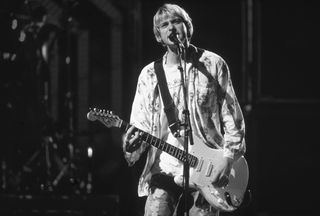
According to Rick King, owner of Guitar Maniacs, Cobain “bought a whole bunch of Univox Hi-Flyers – both the P-90 version and ones with humbuckers. Those pickups have huge output and are completely over the top. He broke a lot of those guitars. We sold him several of them for an average of $100 each over the course of five years.”
Although humbucker-equipped Univox Hi-Flyers apparently were Cobain's favorite guitars in the pre-Nevermind days, he often appeared on stage with other models, including a blue Gibson SG and a sunburst left-handed Greco Mustang copy he bought from Guitar Maniacs.
Cobain purchased what probably was his first acoustic guitar, a Stella 12-string, for $31.21 on October 12, 1989. He brought the Stella to Smart Studios in Wisconsin to record some demos with Butch Vig in April 1990. The guitar wasn't exactly a studio musician's dream.
“It barely stays in tune,” Cobain told Jeff Gilbert in a February 1992 Guitar World interview. "I have to use duct tape to hold the tuning keys in place." At some point in the Stella's history, the steel strings had been replaced with six nylon strings, only five of which were intact during the session.
However, the guitar sounded good enough to Vig, who recorded Cobain playing a solo acoustic version of Polly on that guitar. That track can be heard on Nevermind.
Cobain didn't seem to be exceptionally particular about what equipment he was playing through, with the notable exception of his effects pedals. Sometime in 1990, he bought an Electro-Harmonix Small Clone from Guitar Maniacs, and it remained a favorite and essential part of his setup to the end of his life.
On January 1, 1991, Cobain used the Small Clone to record Aneurysm, which later was issued as the B-side to the Smells Like Teen Spirit single.
Breeding ground: the recording of Nevermind
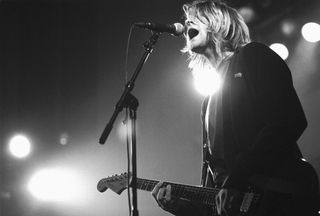
Prior to formally signing with Geffen Records on April 30, 1991, Nirvana received a $287,000 advance for the recording of Nevermind. The advance was somewhat meager, but it gave the band some freedom in choosing equipment. However, Cobain didn't exactly go wild with his spending.
“I sold Kurt a bunch of guitars and effects for the Nevermind album,” says Rick King. “When they got signed to Geffen and started getting money, Kurt was still very frugal. He bought some Japanese left-handed Strats and had humbuckers installed in the Strats' lead position. He didn't spend very much money on guitars.”
Apparently Cobain developed a taste for Fender guitars just prior to recording Nevermind. “I like guitars in the Fender style because they have skinny necks,” said Cobain in a late 1991 interview.
“I've resorted to Japanese-made Fender Stratocasters because they're the most available left-handed guitars." During this period, he also acquired a left-handed '65 Jaguar that had a DiMarzio Super Distortion humbucker in the bridge position and a DiMarzio PAF in the neck position in place of the guitar's stock single-coil pickups. [Editor's note: the original owner and modifier of the Jaguar was most likely Martin Jenner, session guitarist for Cliff Richard and The Everly Brothers.]
I can never find an amp that's powerful enough, and I don't want to deal with hauling 10 Marshall heads. I'm lazy – I like to have it all in one package
Kurt Cobain
These modifications were made before Cobain purchased the guitar. He also bought a left-handed, Lake Placid Blue '69 Fender Competition Mustang around then.
“Out of all the guitars in the whole world, the Fender Mustang is my favorite,” Cobain told GW. “They're cheap and totally inefficient, and they sound like crap and are very small. They also don't stay in tune, and when you want to raise the string action on the fretboard, you have to loosen all the strings and completely remove the bridge.
“You have to turn these little screws with your fingers and hope that you've estimated it right. If you screw up, you have to repeat the process over and over until you get it right. Whoever invented that guitar was a dork. I guess I'm calling Leo Fender, the dead guy, a dork.”
To overcome these tuning problems, Cobain had his '69 Mustang fitted with a Gotoh Tune-O-Matic bridge, a modification that was routinely performed on the Mustangs he subsequently acquired.
Some claim that Cobain's preference for low-end guitars was a punk statement, but he insisted that it was a matter of necessity. “I don't favor them,” Cobain told Guitar World in 1992. “I can afford them. I'm left-handed and it's not very easy to find reasonably priced, high-quality left-handed guitars.”
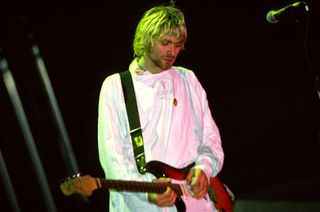
Before entering the studio, Cobain purchased a rack rig consisting of a Mesa/Boogie Studio preamp, a Crown power amp and a variety of Marshall 4x12 cabinets.
“I can never find an amp that's powerful enough,” Cobain told GW. “And I don't want to deal with hauling 10 Marshall heads. I'm lazy – I like to have it all in one package. For a preamp I have a Mesa/Boogie, and I turn all the midrange up.”
Cobain brought this rig along with his Mustang, Jaguar, a Japanese Strat and his Boss DS-1 and Electro-Harmonix Small Clone pedals to Sound City Studios in Van Nuys, California, where the band recorded Nevermind with Butch Vig.
"Kurt had a Mesa/Boogie, but we also used a Fender Bassman a lot and a Vox AC30 on Nevermind," Vig recalls. "I prefer getting the amp to sound distorted instead of using special effects or pedals, which lose body and the fullness of the bottom end."
Still, Vig allowed Cobain to use a few pedals on the album, especially since the guitarist felt that the DS-1 was the main factor in his tone. Cobain also used the Small Clone liberally.
“That's making the watery guitar sound you hear on the pre-chorus build-up of Smells Like Teen Spirit and also Come As You Are,” says Vig. “We used an Electro-Harmonix Big Muff fuzz box through a Fender Bassman on Lithium to get that thumpier, darker sound.”
Cobain's pawn shop Stella was used again for Something in the Way. Vig recorded the performance while Cobain sat on a couch in the control room. Against Vig's wishes, Cobain plugged his guitar direct into the board for Territorial Pissings.
During the recording of Lithium, Cobain instigated the noise jam that became the "hidden" track Endless, Nameless. (This track does not appear on the first 50,000 copies of the CD.) Towards the end of the track, Cobain can be heard smashing his Japanese Stratocaster.
Chris is the co-author of Eruption - Conversations with Eddie Van Halen. He is a 40-year music industry veteran who started at Boardwalk Entertainment (Joan Jett, Night Ranger) and Roland US before becoming a guitar journalist in 1991. He has interviewed more than 600 artists, written more than 1,400 product reviews and contributed to Jeff Beck’s Beck 01: Hot Rods and Rock & Roll and Eric Clapton’s Six String Stories.
Most Popular









